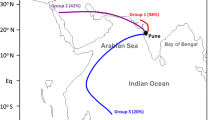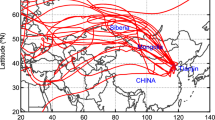Abstract
To understand the aerosol characteristics in a regional background environment, fine-particle (PM2.5, n = 228) samples were collected over a one-year period at the Shangdianzi (SDZ) station, which is a Global Atmospheric Watch regional background station in North China. The chemical and optical characteristics of PM2.5 were analyzed, including organic carbon, elemental carbon, water-soluble organic carbon, water-soluble inorganic ions, and fluorescent components of water-soluble organic matter. The source factors of major aerosol components are apportioned, and the sources of the fluorescent chromophores are further analyzed. The major chemical components of PM2.5 at SDZ were NO3−, organic matter, SO42−, and NH4+. Annually, water-soluble organic carbon contributed 48% ± 15% to the total organic carbon. Secondary formation (52%) and fossil fuel combustion (63%) are the largest sources of water-soluble organic matter and water-insoluble organic matter, respectively. In addition, three humic-like and one protein-like matter were identified via parallel factor analysis for excitation—emission matrices. The fluorescence intensities of the components were highest in winter and lowest in summer, indicating the main impact of burning sources. This study contributes to understanding the chemical and optical characteristics of ambient aerosols in the background atmosphere.
摘 要
地处北京市远郊区的上甸子区域大气本底站气溶胶的化学组分浓度,能很好地代表京津冀地区大气区域本底的背景浓度,同时也反映北京城区和周边地区污染物传输的影响。本文在上甸子站采集了四个季节共228个PM2.5样品,通过分析其化学组分和荧光性质,包括有机碳、元素碳、水溶性有机碳、水溶性无机离子以及水溶性有机物的荧光组分,并利用气团后向轨迹和**矩阵因数分解法解析来源,为进一步研究京津冀地区气溶胶本底浓度变化,特别是人类活动如何影响背景地区气溶胶形成提供观测依据。结果表明,上甸子PM2.5的化学组分与城市气溶胶组成基本一致,主要为NO3-、有机物、SO42-和NH4+。其中,SO42-在夏季浓度最高,其他组分浓度是秋季最高。水溶性有机碳占总有机碳的48%±15%。大气二次生成(52%)和化石燃料燃烧(63%)分别是水溶性有机物和水不溶性有机物的最大来源。运用**行因子分析法解析三维荧光光谱确定三种类腐殖酸和一种类蛋白荧光组分,荧光**度在冬季最**、夏季最弱。荧光**度的季节变化和荧光指数表明,水溶性荧光物质主要是燃烧源和二次生成的贡献,少量来源于微生物源。与冬季相比,夏季大气荧光物质更倾向于高度腐殖化或高度芳香化。研究发现,即使在上甸子这样的空气洁净地区,化石燃料燃烧和生物质燃烧等人为排放源对气溶胶的贡献也非常显著。
Similar content being viewed by others
References
Brown, S. G., S. Eberly, P. Paatero, and G. A. Norris, 2015: Methods for estimating uncertainty in PMF solutions: Examples with ambient air and water quality data and guidance on reporting PMF results. Science of the Total Environment, 518–519, 626–635, https://doi.org/10.1016/j.scitotenv.2015.01.022.
Cao, J., Y. P. Pan, S. S. Yu, B. Zheng, D. S. Ji, J. B. Hu, and J. Liu, 2022: Rapid decline in atmospheric organic carbon deposition in rural Bei**g, North China between 2016 and 2020. Atmos. Environ., 276, 119030, https://doi.org/10.1016/j.atmosenv.2022.119030.
Carbone, C., and Coauthors, 2014: 3-year chemical composition of free tropospheric PM1 at the Mt. Cimone GAW global station — South Europe — 2165 m a.s.l. Atmos. Environ., 87, 218–227, https://doi.org/10.1016/j.atmosenv.2014.01.048.
Chen, Q. C., F. Ikemori, and M. Mochida, 2016a: Light absorption and excitation-emission fluorescence of urban organic aerosol components and their relationship to chemical structure. Environmental Science & Technology, 50, 10 859–10 868, https://doi.org/10.1021/acs.est.6b02541.
Chen, Q. C., and Coauthors, 2016b: Characterization of chromophoric water-soluble organic matter in urban, forest, and marine aerosols by HR-ToF-AMS analysis and excitation-emission matrix spectroscopy. Environmental Science & Technology, 50, 10 351–10 360, https://doi.org/10.1021/acs.est.6b01643.
Chen, Q. C., F. Ikemori, Y. Nakamura, P. Vodicka, K. Kawamura, and M. Mochida, 2017: Structural and light-absorption characteristics of complex water-insoluble organic mixtures in urban submicrometer aerosols. Environmental Science & Technology, 51, 8293–8303, https://doi.org/10.1021/acs.est.7b01630.
Chen, Q. C., Z. Mu, W. H. Song, Y. Q. Wang, Z. H. Yang, L. X. Zhang, and Y.-L. Zhang, 2019: Size-resolved characterization of the chromophores in atmospheric particulate matter from a typical coal-burning city in China. J. Geophys. Res., 124, 10 546–10 563, https://doi.org/10.1029/2019JD031149.
Chen, Q. C., X. Y. Hua, and A. Dyussenova, 2021: Evolution of the chromophore aerosols and its driving factors in summertime **’an, Northwest China. Chemosphere, 281, 130838, https://doi.org/10.1016/j.chemosphere.2021.130838.
Chen, S., and Coauthors, 2022: Source and formation process impact the chemodiversity of rainwater dissolved organic matter along the Yangtze River Basin in summer. Water Research, 211, 118024, https://doi.org/10.1016/j.watres.2021.118024.
Coble, P. G., 2007: Marine optical biogeochemistry: The chemistry of ocean color. Chemical Reviews, 107, 402–418, https://doi.org/10.1021/cr050350+.
Cong, Z. Y., K. Kawamura, S. C. Kang, and P. Q. Fu, 2015: Penetration of biomass-burning emissions from South Asia through the Himalayas: New insights from atmospheric organic acids. Scientific Reports, 5, 9580, https://doi.org/10.1038/srep09580.
Finlayson-Pitts, B. J., L. M. Wingen, V. Perraud, and M. J. Ezell, 2020: Open questions on the chemical composition of airborne particles. Communications Chemistry, 3, 108, https://doi.org/10.1038/s42004-020-00347-4.
Fu, P. Q., K. Kawamura, K. Okuzawa, S. G. Aggarwal, G. H. Wang, Y. Kanaya, and Z. F. Wang, 2008: Organic molecular compositions and temporal variations of summertime mountain aerosols over Mt. Tai, North China Plain. J. Geophys. Res., 113, D19107, https://doi.org/10.1029/2008JD009900.
Fu, P. Q., and Coauthors, 2015: Fluorescent water-soluble organic aerosols in the High Arctic atmosphere. Scientific Reports, 5, 9845, https://doi.org/10.1038/srep09845.
Glasius, M., and A. H. Goldstein, 2016: Recent discoveries and future challenges in atmospheric organic chemistry. Environmental Science & Technology, 50, 2754–2764, https://doi.org/10.1021/acs.est.5b05105.
Goldstein, A. H., and I. E. Galbally, 2007: Known and unexplored organic constituents in the earth’s atmosphere. Environmental Science & Technology, 41, 1514–1521, https://doi.org/10.1021/es072476p.
Hänel, A., H. Baars, D. Althausen, A. Ansmann, R. Engelmann, and J. Y. Sun, 2012: One-year aerosol profiling with EUCAARI Raman lidar at Shangdianzi GAW station: Bei**g plume and seasonal variations. J. Geophys. Res., 117, D13201, https://doi.org/10.1029/2012JD017577.
Huang, S., W. Hu, J. Chen, Z. J. Wu, D. Z. Zhang, and P. Q. Fu, 2021: Overview of biological ice nucleating particles in the atmosphere. Environment International, 146, 106197, https://doi.org/10.1016/j.envint.2020.106197.
Huguet, A., L. Vacher, S. Relexans, S. Saubusse, J. M. Froide-fond, and E. Parlanti, 2009: Properties of fluorescent dissolved organic matter in the Gironde Estuary. Organic Geochemistry, 40, 706–719, https://doi.org/10.1016/j.orggeochem.2009.03.002.
Ji, D. S., and Coauthors, 2019: The carbonaceous aerosol levels still remain a challenge in the Bei**g-Tian**-Hebei region of China: Insights from continuous high temporal resolution measurements in multiple cities. Environment International, 126, 171–183, https://doi.org/10.1016/j.envint.2019.02.034.
Khan, J. Z., L. Sun, Y. Z. Tian, G. L. Shi, and Y. C. Feng, 2021: Chemical characterization and source apportionment of PM1 and PM2.5 in Tian**, China: Impacts of biomass burning and primary biogenic sources. Journal of Environmental Sciences, 99, 196–209, https://doi.org/10.1016/j.jes.2020.06.027.
Lang, J. L., and Coauthors, 2017: Trends of PM2.5 and chemical composition in Bei**g, 2000–2015. Aerosol and Air Quality Research, 17, 412–425, https://doi.org/10.4209/aaqr.2016.07.0307.
Lawaetz, A. J., and C. A. Stedmon, 2009: Fluorescence intensity calibration using the Raman scatter peak of water. Applied Spectroscopy, 63, 936–940, https://doi.org/10.1366/000370209788964548.
Lee, H. J., A. Laskin, J. Laskin, and S. A. Nizkorodov, 2013: Excitation-emission spectra and fluorescence quantum yields for fresh and aged biogenic secondary organic aerosols. Environmental Science & Technology, 47, 5763–5770, https://doi.org/10.1021/es400644c.
Li, J. J., and Coauthors, 2021: Effects of atmospheric aging processes on in vitro induced oxidative stress and chemical composition of biomass burning aerosols. Journal of Hazardous Materials, 401, 123750, https://doi.org/10.1016/j.jhazmat.2020.123750.
Li, X. F., and Coauthors, 2022: Molecular compositions, optical properties, and implications of dissolved brown carbon in snow/ice on the Tibetan Plateau glaciers. Environment International, 164, 107276, https://doi.org/10.1016/j.envint.2022.107276.
Li, X. R., R. Y. Zhang, X. G. Cong, L. L. Cheng, J. Liu, and H. H. Xu, 2015: Characterization of the size-segregated inorganic compounds in Lin’an, a regional atmosphere background station in the Yangtze River Delta region. Atmospheric Pollution Research, 6, 1058–1065, https://doi.org/10.1016/j.apr.2015.06.002.
Li, Y., J. Tao, L. M. Zhang, X. F. Jia, and Y. F. Wu, 2016: High contributions of secondary inorganic aerosols to PM2.5 under polluted levels at a regional station in Northern China. International Journal of Environmental Research and Public Health, 13, 1202, https://doi.org/10.3390/ijerph13121202.
McKnight, D. M., E. W. Boyer, P. K. Westerhoff, P. T. Doran, T. Kulbe, and D. T. Andersen, 2001: Spectrofluorometric characterization of dissolved organic matter for indication of precursor organic material and aromaticity. Limnology and Oceanography, 46, 38–48, https://doi.org/10.4319/lo.2001.46.1.0038.
Mu, Q., and Coauthors, 2018: Temperature effect on phase state and reactivity controls atmospheric multiphase chemistry and transport of PAHs. Science Advances, 4, eaap7314, https://doi.org/10.1126/sciadv.aap7314.
Murphy, K. R., C. A. Stedmon, D. Graeber, and R. Bro, 2013: Fluorescence spectroscopy and multi-way techniques. PARAFAC. Analytical Methods, 5, 6557–6566, https://doi.org/10.1039/C3AY41160E.
Ohno, T., and R. Bro, 2006: Dissolved organic matter characterization using multiway spectral decomposition of fluorescence landscapes. Soil Science Society of America Journal, 70, 2028–2037, https://doi.org/10.2136/sssaj2006.0005.
Paatero, P., and U. Tapper, 1994: Positive matrix factorization: A non-negative factor model with optimal utilization of error estimates of data values. Environmetrics, 5, 111–126, https://doi.org/10.1002/env.3170050203.
Pavuluri, C. M., K. Kawamura, S. G. Aggarwal, and T. Swaminathan, 2011: Characteristics, seasonality and sources of carbonaceous and ionic components in the tropical aerosols from Indian region. Atmospheric Chemistry and Physics, 11, 8215–8230, https://doi.org/10.5194/acp-11-8215-2011.
Polissar, A. V., P. K. Hopke, P. Paatero, W. C. Malm, and J. F. Sisler, 1998: Atmospheric aerosol over Alaska: 2. Elemental composition and sources. J. Geophys. Res., 103, 19 045–19 057, https://doi.org/10.1029/98JD01212.
Pöschl, U., 2005: Atmospheric aerosols: Composition, transformation, climate and health effects. Angewandte Chemie International Edition, 44, 7520–7540, https://doi.org/10.1002/anie.200501122.
Pu, W. W., and Coauthors, 2020: Regional transport and urban emissions are important ammonia contributors in Bei**g, China. Environmental Pollution, 265, 115062, https://doi.org/10.1016/j.envpol.2020.115062.
Qi, M. X., L. Jiang, Y. X. Liu, Q. L. **ong, C. Y. Sun, X. Li, W. J. Zhao, and X. C. Yang, 2018: Analysis of the characteristics and sources of carbonaceous aerosols in PM2.5 in the Bei**g, Tian**, and Langfang region, China. International Journal of Environmental Research and Public Health, 15, 1483, https://doi.org/10.3390/ijerph15071483.
Qin, J. J., L. M. Zhang, X. M. Zhou, J. C. Duan, S. T. Mu, K. **ao, J. N. Hu, and J. H. Tan, 2018: Fluorescence fingerprinting properties for exploring water-soluble organic compounds in PM2.5 in an industrial city of northwest China. Atmos. Environ., 184, 203–211, https://doi.org/10.1016/j.atmosenv.2018.04.049.
Qu, W. J., X. Y. Zhang, R. Arimoto, D. Wang, Y. Q. Wang, L. W. Yan, and Y. Li, 2008: Chemical composition of the background aerosol at two sites in southwestern and northwestern China: Potential influences of regional transport. Tellus B: Chemical and Physical Meteorology, 60, 657–673, https://doi.org/10.1111/j.1600-0889.2008.00342.x.
Qu, W.-J., X.-Y. Zhang, R. Arimoto, Y.-Q. Wang, D. Wang, L.-F. Sheng, and G. Fu, 2009: Aerosol background at two remote CAWNET sites in western China. Science of the Total Environment, 407, 3518–3529, https://doi.org/10.1016/j.scitotenv.2009.02.012.
Reynolds, E., 2020: Air pollution a cause of UK girl’s death, finds global landmark ruling. CNN, December 16, https://www.cnn.com/2020/12/16/uk/air-pollution-death-ella-kissi-debrah-uk-gbr-intl.
Shrivastava, M., and Coauthors, 2019: Urban pollution greatly enhances formation of natural aerosols over the Amazon rainforest. Nature Communications, 10, 1046, https://doi.org/10.1038/s41467-019-08909-4.
Su, J., P. S. Zhao, J. Ding, X. Du, and Y. J. Dou, 2021: Insights into measurements of water-soluble ions in PM2.5 and their gaseous precursors in Bei**g. Journal of Environmental Sciences, 102, 123–137, https://doi.org/10.1016/j.jes.2020.08.031.
Tang, J., and Coauthors, 2021: Measurement report: Long-emission-wavelength chromophores dominate the light absorption of brown carbon in aerosols over Bangkok: Impact from biomass burning. Atmospheric Chemistry and Physics, 21, 11 337–11 352, https://doi.org/10.5194/acp-21-11337-2021.
Tang, Q., Y. Lei, G. Yan, W. B. Xue, and X. Y. Wang, 2020: Characteristics of heavy air pollution in Bei**g-Tian**-Hebei and the surrounding areas during autumn and winter and policy recommendations. IOP Conference Series: Earth and Environmental Science, 569, 012041, https://doi.org/10.1088/1755-1315/569/1/012041.
Wang, G. H., K. Kawamura, S. Lee, K. Ho, and J. J. Cao, 2006: Molecular, seasonal, and spatial distributions of organic aerosols from fourteen Chinese cities. Environmental Science & Technology, 40, 4619–4625, https://doi.org/10.1021/es060291x.
Wang, Y. Q., 2014: MeteoInfo: GIS software for meteorological data visualization and analysis. Meteorological Applications, 21, 360–368, https://doi.org/10.1002/met.1345.
Wu, D., X. X. Tie, and X. J. Deng, 2006: Chemical characterizations of soluble aerosols in southern China. Chemosphere, 64, 749–757, https://doi.org/10.1016/j.chemosphere.2005.11.066.
Wu, G. M., and Coauthors, 2019: Water-soluble brown carbon in atmospheric aerosols from godavari (Nepal), a regional representative of South Asia. Environmental Science & Technology, 53, 3471–3479, https://doi.org/10.1021/acs.est.9b00596.
Wu, G. M., and Coauthors, 2021a: Fluorescence characteristics of water-soluble organic carbon in atmospheric aerosol. Environmental Pollution, 268, 115906, https://doi.org/10.1016/j.envpol.2020.115906.
Wu, L. B., and Coauthors, 2021b: Source forensics of inorganic and organic nitrogen using δ15N for tropospheric aerosols over Mt. Tai. npj Climate and Atmospheric Science, 4, 8, https://doi.org/10.1038/s41612-021-00163-0.
Wu, W. Q., M. Zhang, and Y. T. Ding, 2020: Exploring the effect of economic and environment factors on PM2.5 concentration: A case study of the Bei**g-Tian**-Hebei region. Journal of Environmental Management, 268, 110703, https://doi.org/10.1016/j.jenvman.2020.110703.
**e, M. J., N. Mladenov, M. W. Williams, J. C. Neff, J. Wasswa, and M. P. Hannigan, 2016: Water soluble organic aerosols in the Colorado Rocky Mountains, USA: Composition, sources and optical properties. Scientific Reports, 6, 39339, https://doi.org/10.1038/srep39339.
**e, X. C., and Coauthors, 2020: Light-absorbing and fluorescent properties of atmospheric brown carbon: A case study in Nan**g, China. Chemosphere, 251, 126350, https://doi.org/10.1016/j.chemosphere.2020.126350.
Xu, W., and Coauthors, 2019: Impact of emission controls on air quality in Bei**g during APEC 2014: Implications from water-soluble ions and carbonaceous aerosol in PM2.5 and their precursors. Atmos. Environ., 210, 241–252, https://doi.org/10.1016/j.atmosenv.2019.04.050.
Yan, G., and G. Kim, 2017: Speciation and sources of brown carbon in precipitation at Seoul, Korea: Insights from excitation-emission matrix spectroscopy and carbon isotopic analysis. Environmental Science & Technology, 51, 11 580–11 587, https://doi.org/10.1021/acs.est.7b02892. https://doi.org/10.1021/acs.est.7b02892.
Yan, P., N. Huan, Y. M. Zhang, and H. G. Zhou, 2012a: Size resolved aerosol OC, EC at a regional background station in the suburb of Bei**g. Journal of Applied Meteorological Science, 23, 285–293, https://doi.org/10.3969/j.issn.1001-7313.2012.03.004. (in Chinese with English abstract)
Yan, P., R. J. Zhang, N. Huan, X. J. Zhou, Y. M. Zhang, H. G. Zhou, and L. M. Zhang, 2012b: Characteristics of aerosols and mass closure study at two WMO GAW regional background stations in eastern China. Atmos. Environ., 10, 121–131, https://doi.org/10.1016/j.atmosenv.2012.05.050.
Yang, D. Z., X. L. Yu, X. M. Fang, F. Wu, and X. S. Li, 1996: A study of aerosol at regional backgroundstations and baseline station. Quarterly Journal of Applied Meteorlolgy, 2, 396–405. (in Chinese with English abstract)
Yang, Y. J., R. Zhou, Y. Yu, Y. Yan, Y. Liu, Y. Di, D. Wu, and W. Q. Zhang, 2017: Size-resolved aerosol water-soluble ions at a regional background station of Bei**g, Tian**, and Hebei, North China. Journal of Environmental Sciences, 55, 146–156, https://doi.org/10.1016/j.jes.2016.07.012.
Ye, Y. Q., H. C. Zhan, X. W. Yu, J. Li, X. M. Wang, and Z. Q. **e, 2021: Detection of organosulfates and nitrooxyorganosulfates in Arctic and Antarctic atmospheric aerosols, using ultra-high resolution FT-ICR mass spectrometry. Science of the Total Environment, 212, 144339, https://doi.org/10.1016/j.scitotenv.2020.144339.
Yi, Y., Y. N. Zhang, H. W. Liu, P. P. Tian, Y. F. Li, Y. Lei, and Y. B. Wang, 2020: Spectral characteristics and source analysis of WSOC of PM2.5 in winter of **’an. Environmental Science, 41, 3924–3931, https://doi.org/10.13227/j.hjkx.202001127. (in Chinese with English abstract)
Yue, S. Y., H. Ren, S. Y. Fan, Y. L. Sun, Z. F. Wang, and P. Q. Fu, 2016: Springtime precipitation effects on the abundance of fluorescent biological aerosol particles and HULIS in Bei**g. Scientific Reports, 6, 29618, https://doi.org/10.1038/srep29618.
Yue, S. Y., and Coauthors, 2017: High abundance of fluorescent biological aerosol particles in winter in Bei**g, China. ACS Earth and Space Chemistry, 1, 493–502, https://doi.org/10.1021/acsearthspacechem.7b00062.
Yue, S. Y., and Coauthors, 2019: Abundance and diurnal trends of fluorescent bioaerosols in the troposphere over Mt. Tai, China, in Spring. J. Geophys. Res., 124, 4158–4173, https://doi.org/10.1029/2018JD029486.
Yue, S. Y., and Coauthors, 2022a: Biological and nonbiological sources of fluorescent aerosol particles in the urban atmosphere. Environmental Science & Technology, 56, 7588–7597, https://doi.org/10.1021/acs.est.1c07966.
Yue, S. Y., and Coauthors, 2022b: Brown carbon from biomass burning imposes strong circum-Arctic warming. One Earth, 5, 293–304, https://doi.org/10.1016/j.oneear.2022.02.006.
Zhan, Y. N., J. L. Li, N. T. Tsona, B. Chen, C. Q. Yan, C. George, and L. Du, 2022: Seasonal variation of water-soluble brown carbon in Qingdao, China: Impacts from marine and terrestrial emissions. Environ. Res., 212, 113144, https://doi.org/10.1016/j.envres.2022.113144.
Zhang, C., and Coauthors, 2021: Light absorption and fluorescence characteristics of water-soluble organic compounds in carbonaceous particles at a typical remote site in the southeastern Himalayas and Tibetan Plateau. Environmental Pollution, 272, 116000, https://doi.org/10.1016/j.envpol.2020.116000.
Zhang, R. Y., and Coauthors, 2015: Formation of urban fine particulate matter. Chemical Reviews, 115, 3803–3855, https://doi.org/10.1021/acs.chemrev.5b00067.
Zhao, P. S., F. Dong, Y. D. Yang, D. He, X. J. Zhao, W. Z. Zhang, Q. Yao, and H. Y. Liu, 2013a: Characteristics of carbonaceous aerosol in the region of Bei**g, Tian**, and Hebei, China. Atmos. Environ., 71, 389–398, https://doi.org/10.1016/j.atmosenv.2013.02.010.
Zhao, P. S., F. Dong, D. He, X. J. Zhao, X. L. Zhang, W. Z. Zhang, Q. Yao, and H. Y. Liu, 2013b: Characteristics of concentrations and chemical compositions for PM2.5 in the region of Bei**g, Tian**, and Hebei, China. Atmospheric Chemistry and Physics, 13, 4631–4644, https://doi.org/10.5194/acp-13-4631-2013.
Zhao, P. S., Y. N. Chen, and J. Su, 2017: Size-resolved carbonaceous components and water-soluble ions measurements of ambient aerosol in Bei**g. Journal of Environmental Sciences, 54, 298–313, https://doi.org/10.1016/j.jes.2016.08.027.
Zhao, W. Y., and Coauthors, 2018: Molecular distribution and compound-specific stable carbon isotopic composition of dicarboxylic acids, oxocarboxylic acids and α-dicarbonyls in PM2.5 from Bei**g, China. Atmospheric Chemistry and Physics, 18, 2749–2767, https://doi.org/10.5194/acp-18-2749-2018.
Zhao, W. Y., and Coauthors, 2019: Excitation-emission matrix fluorescence, molecular characterization and compound-specific stable carbon isotopic composition of dissolved organic matter in cloud water over Mt. Tai. Atmos. Environ., 213, 608–619, https://doi.org/10.1016/j.atmosenv.2019.06.034.
Zheng, M., L. G. Salmon, J. J. Schauer, L. M. Zeng, C. S. Kiang, Y. H. Zhang, and G. R. Cass, 2005: Seasonal trends in PM2.5 source contributions in Bei**g, China. Atmos. Environ., 39, 3967–3976, https://doi.org/10.1016/j.atmosenv.2005.03.036.
Zou, B., J. W. You, Y. Lin, X. L. Duan, X. G. Zhao, X. Fang, M. J. Campen, and S. X. Li, 2019: Air pollution intervention and life-saving effect in China. Environment International, 125, 529–541, https://doi.org/10.1016/j.envint.2018.10.045.
Zsolnay, A., E. Baigar, M. Jimenez, B. Steinweg, and F. Saccomandi, 1999: Differentiating with fluorescence spectroscopy the sources of dissolved organic matter in soils subjected to drying. Chemosphere, 38, 45–50, https://doi.org/10.1016/S0045-6535(98)00166-0.
Acknowledgements
This study was supported by the National Natural Science Foundation of China (Grant Nos. 42130513 and 41625014) and the National Key Research and Development Program of China (Grant No. 2019YFA0606801). The authors declare that they have no conflicts of interest. The data used in this study are listed in tables, figures, and supplementary materials.
Author information
Authors and Affiliations
Corresponding author
Additional information
Article Highlights
• Chemical and optical characteristics of one-year-round PM2.5 samples were studied from the Shangdianzi background station in North China.
• The major chemical components of PM2.5 at Shangdianzi were NO −3 , followed by organic matter, SO 2−4 , and NH +4 .
• Secondary formation and fossil fuel combustion are the largest sources of water-soluble and water-insoluble organic matter, respectively.
• The main impact of burning sources was identified with the highest fluorescence intensities in winter and the lowest in summer.
Electronic Supplementary Material to
Rights and permissions
About this article
Cite this article
Li, P., Yue, S., Yang, X. et al. Fluorescence Properties and Chemical Composition of Fine Particles in the Background Atmosphere of North China. Adv. Atmos. Sci. 40, 1159–1174 (2023). https://doi.org/10.1007/s00376-022-2208-x
Received:
Revised:
Accepted:
Published:
Issue Date:
DOI: https://doi.org/10.1007/s00376-022-2208-x
Key words
- fine aerosols
- excitation—emission matrix
- fluorescence properties
- primary biological aerosols
- Shangdianzi




